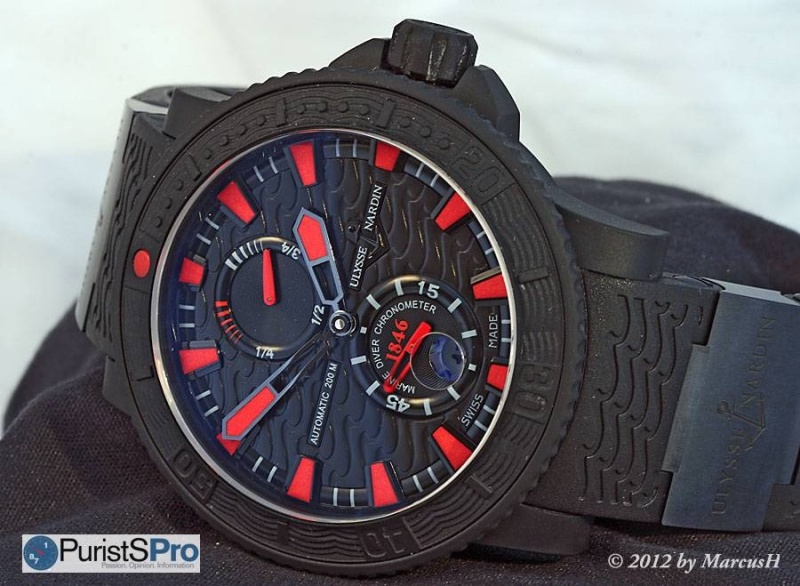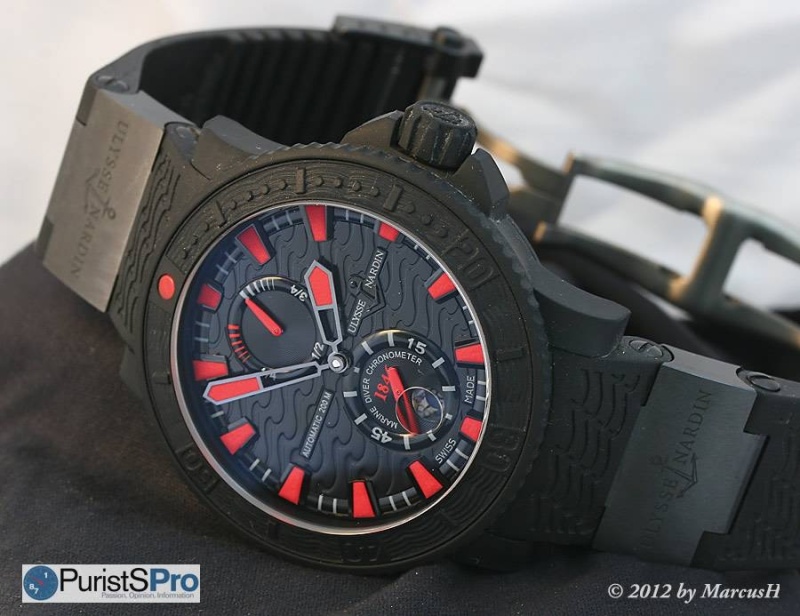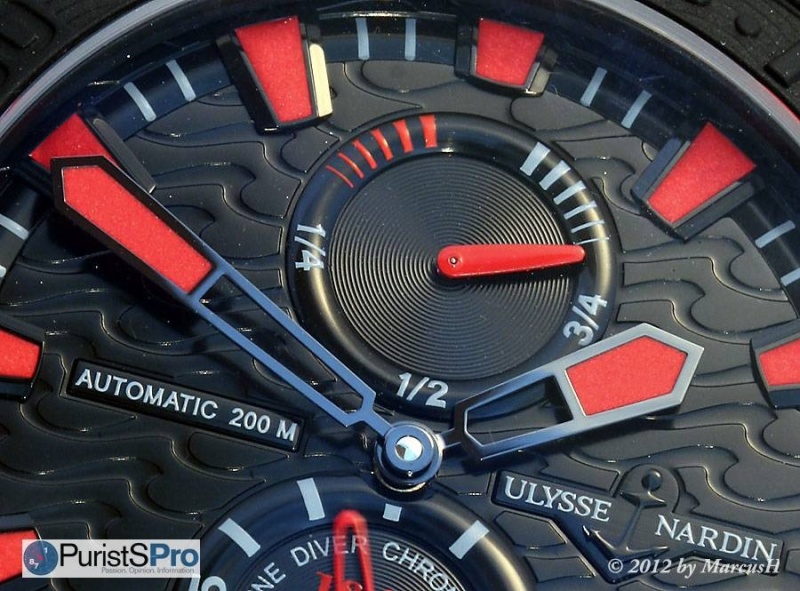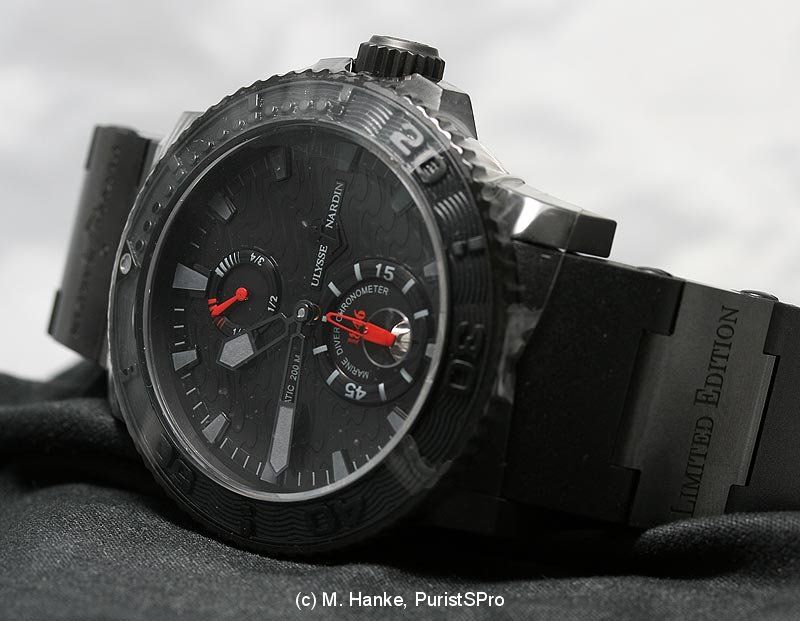
Marcus Hanke
[PuristSPro Moderator]
11515

Ulysse Nardin Marine Diver "Black Sea" In-Depth Review, Part 1
Ulysse Nardin Marine Diver "Black Sea"
Test report by Marcus Hanke
Part 1

Wristwatches with black cases have been popular ever since they were launched. The first really well-known model was released by Orfina in the early 1970s, realizing a design by F.A. Porsche. Until today, this Valjoux 7750-based chronograph is sought after by collectors. The reason for the black watch’s popularity might lie in its reduced reflection signature, which is important for members of special forces, maybe hunters as well. For all others, it is the pure testosterone effect a watch made for “real men” has on us, who we fall a tiny bit short of the “real men culmination level”.
The problem with most blackened watch cases is the vulnerability of their black surface finish to mechanical damage or abrasion. Most black watches gain their appearance through a process called physical vapour deposition, or PVD. Here, a very thin black layer is deposed on the steel case. Unfortunately, this is not very hard and is consequently damaged by scratches rather easily. Such a scratch reveals the bright base material under the black layer, making the scratch even more apparent. Since it is not so simple to reapply a PVD coat to a watch, one has to either be extremely cautious wearing a black watch, in order to prevent any flaws to show - which, btw, is not really what a “real men watch” should be treated like - or accept the various shining dings and lines showing through the black coat as traces of a busy life.
A few years ago, the search for a more scratch-resistant black surface coating resulted in DLC, diamond-like carbon. The process to produce this coating is the same, PVD, but instead of metallic oxides, a thin layer from amorphous carbon is applied. Due to its diamond-like hardness, this layer is highly resistant against abrasions and scratches, but can be compromised by (massive) blows.
DLC initiated a new wave of black watches launched during the last four or five years, sometimes the “black is beautiful”-dogma resulted in “stealth” watches even, where markers and hands alike were black as well, making it very difficult to read the time.
Ulysse Nardin, too, jumped that wagon and launched an all-black Marine Diver with DLC case in 2009.
Now another technical development appeared on the horizon, having started from another end of the watch manufacturing business: In 1999, Blancpain presented its Concept 2000 line, which had some case parts (bezel rim, crown) and bracelet links coated with black rubber. Before, only Audemars Piguet had used rubber on the cases of its Royal Oak Offshore, on the hexagonal crown and as rubber caps on the pushers (which initially were rather easily lost). Blancpain’s choice of materials sparked a debate whether such a rubber coating can be reliable and strong enough to withstand the test of time. Meanwhile, after thirteen years of rubber coating on exposed watch parts, I think this question can be answered positively.
For years, rubber-coated watch components, like bezel and crown, were successfully used, and became rather conventional. Yet these components were mostly in simple shapes, and the rubber coating limited to small surface areas only. In 2009, however, several brands, like IWC, Glashütte Original and Jean Richard, presented watches which had their steel cases completely coated with vulcanized black rubber. Unlike DLC, the rubber finish offers better grip and a completely non-reflective matte surface. Once again, the launch of these watches was quickly followed by discussions about their ruggedness and the durability of the rubber coat.
In 2011, Ulysse Nardin followed the trend by presenting the “Black Sea”, a Maxi Marine Diver, of which the case with all its components (including the revolving bezel, crown and caseback) is coated with vulcanized rubber. Unlike the earlier Stealth Diver, the first “Black Sea” features a highly eye-catching combination of red luminous mass on hands and hourmarkers, red hands of small second and power reserve, shiny black patterns and structures on the dial, and light grey markings and subdivisions.

In my opinion, this configuration makes this “Black Sea” one of the most striking designs in the UN catalogue.
Meanwhile, the “Black Sea” has been expanded into an own line, with models featuring colour accents in bright yellow, white and blue, and most recently also including a chronograph. A limited edition of the Diver, coated with blue rubber, the “Blue Sea”, complements the series since this spring.
The release of the “Black Sea” again was the cause of several questions and discussions on the durability of vulcanized rubber coats on sports watches, which was why I decided to conduct a special test, focussing on this aspect. Since the basic style and movement are the same as that of the original Marine Diver, which I had reviewed several years ago (click here to read the test: quicklook.watchprosite.com ), I did not intend to write another experience review.
However, when the “Black Sea” arrived, it immediately made such an intense impression on everybody looking at it, and felt so differently on the wrist, that I decided it would justify a completely new test report. Additionally, during the ten years passed since the Marine Diver review, some of my test methods and criteria have changed, just as my own perspective.
I. First impression:
This can be summed up as follows: It is big, bold - and wow! Barely a watch of mine stirred so many positive, even enthusiastic comments, from females and males alike. The contrast between the flat black of the rubber and the red of the hands and markers is stunning. While the watch is officially called Marine Diver “Black Sea”, I immediately identified the black of my Weber kettle and the red of the glowing charcoal in it. Consequently, I dubbed the watch Marine Diver “Barbecue”, which might be less grandiose, but much more plausible than its official title.


As already hinted, the “Barbecue” - sorry - the “Black Sea” is a rather massive timepiece: its diameter is more than 45mm, its height about 14mm, and it weighs 138 grams, with the standard rubber/ceramic bracelet.
II. Case, crystal and crown:
The first grip on the watch case already reveals the “Black Sea’s” exclusive feature: the fingers seeking for grip get grip. At first, it is a somewhat weird feeling, to have the well-known shapes of a watch, normally cool, shiny and smooth responding soft, yet firm, a little bit elastic to the pressure of the finger tips.
As already stated, the complete watch case is coated with vulcanized rubber. This is not done by the case manufacturer, but by another company, that is also active for other watch manufacturers as well. Since the rubber coat is about 0.6 millimeters thick, one cannot simply take a standard steel case from the shelf, but has to produce cases with different dimensions, under consideration of the added rubber.

While the use of rubber-coated cases is not a feature exclusive to Ulysse Nardin, all other watches I am aware of have less sophisticated and fine details: especially the Marine Diver’s revolving bezel, which is milled with a fine wave pattern and figures in profile. I can assure that even the most elaborate details of the case are perfectly reproduced and modelled by the rubber coat.


Every visible part of the case is rubber-coated, including the inner sides of the lugs (lug width 22mm), the only exception being the traditional serial number plate screwed to the side. All rubber-coated watch cases of the unlimited series bear unique case numbers.

Typical for the Marine series cases are the concave sides. On steel or gold cases this effectively helps to prevent scratches, since this shape simply keeps the material out of the way from potential harm. Here, the rubber coat of course is a good protection shield already.
The display case back is held by six screws and permits the view on the ETA 2892A2 base movement, which is nicely decorated with circular stripes and a black rotor. The display back is also responsible for the reduced water tightness rating of 200 meters, a hundred meters less than the Ulysse Nardin Marine Divers with solid case back; not that this would make a substantial difference in everyday practice.

The unidirectionally revolving bezel features a luminous marker at the 60 minutes position, equipped with the same red SuperLuminova that is also used on the dial and hands. When examined close up, it is noticed that this luminous dot is missing the protecting sapphire crystal disk that is present on the bezels of all other Marine Diver watches. I assume this is because the rubber coating does not allow the attachment of such a tiny protective crystal. The result is that the luminous dot is more or less the only part of the whole watch that is prone to scratches.


The lower picture shows the protective sapphire on the luminous dot of the standard Marine Diver
To assure the durability of the coat, exhaustive tests were conducted already by the case manufacturer, then again by Ulysse Nardin, showing no indication of a tendency to flake off, or of visible wear. In addition to this, I was able to wear the watch reviewed in several rough situations, and the watch passed these, including the exposure to several aggressive chemicals, without even the slightest sign of wear or damage. To read the test report, please click here: ulyssenardin.watchprosite.com

The flat sapphire crystal has a magnification loupe for the date grinded into its rear side, and features an efficient anti-reflective coating on both sides. However, this makes water drops (or my dogs’ slobber) leave highly visible traces on the crystal.

The rubber coat also offers perfect grip to the large screw-down crown, which is protected by two massive crown guards on the case.


III. Dial and hands
A very attractive three-dimensional wave pattern adorns the black dial, with domed rings limiting the two subdials of the power reserve at 12 and the small second at 6. The print of the text and the minutes and seconds markers is not executed in bright white, but in a light grey, which does not compromise the dominating effect of the red luminous elements, but is still clearly legible. A concession to the oversized hour markers with their shiny black facets is the fact that only two minute markings fit between two hour markers, which makes an accurate reading and setting more difficult near the hour markers.
The execution of the dial and the markers is flawless, there is absolutely no flaw or particle visible even under high magnification.




This cannot be stated about all hands, though: Already a rather weak (3x) loupe reveals that the small red hand of the power reserve has a problem: Apparently, the paint was applied too thick, and the sides of the hand were not cleaned, resulting in conspicuous varnish tears.


Of course I am aware of the difficulties for the watch manufacturers to check the hands sent from the supplier for quality defects. Each delivery consists of several thousand tiny hands, stuck into pieces of cardboard. It is impossible to retrieve all of them from this cardboard for close inspection without risking to damage these most delicate parts, let alone the work hours this procedure would cost. Yet in my opinion, it is the responsibility of the supplier to guarantee flawless products and to conduct serious quality checks before they leave his facilities.
Finally it remains the individual assembling watchmaker’s discretion whether he uses a part or rejects it: under his loupe such a quality flaw should be clearly visible.
However, the pictures above, when sent to Ulysse Nardin with the request for a comment, stirred immediate activity: the other hands from this delivery were subjected to scrutiny, and as it appears, the hand in question was the only one with this kind of flaw. And I am positive this painted hand will be the cause for increased efforts of the watchmakers, not to let similarly compromised components slip through during assembly.
The other hands, especially the polished black hands for hour and minute, are flawless.



Compared with the traditional Marine Diver and Maxi Marine Diver, the more recent generation of Divers replaced the classic-looking hands for power reserve and small second with a more modern design, distantly reminding of a surfboard. Thus they match the wave pattern on the dial nicely, and overall add a bit of boldness.

Continue to Part 2 by clicking here: ulyssenardin.watchprosite.com
/
Copyright August 2012 - Marcus Hanke & PuristSPro.com - all rights reserved
PuristSPro Homepage | ThePuristS Homepage

This message has been edited by Marcus Hanke on 2012-09-05 05:09:18 This message has been edited by MTF on 2012-09-13 12:10:23
More posts:

Ulysse Nardin Marine Diver "Black Sea" In-Depth Review, Part 1
Ulysse Nardin Marine Diver "Black Sea" Test report by Marcus Hanke Part 1 Wristwatches with black cases have been popular ever since they were launched. The first really well-known model was released by Orfina in the early 1970s, realizing a design by F.A...

Thank you, Marcus, for performing yet another . . .
. . . thorough and objective review. One can tell that your admiration for the whole doesn't prejudice your typical attention to detail. One question: were there any frustrations experienced with setting time? Other variations of the subsidiary seconds ve...

Setting issues ...
Thank you for your compliments, Art, and your question, of course: Indeed, it is a bit difficult to exactly set the correct time due to the oversized hour markers and missing minute markers as a consequence. For example: It is easy to accurately set the t...

Impressions of the UN Black Sea
Thanks Marcus for your in-depth review of the UN Marine Diver Black Sea. It's interesting to see the differences between the original 2009 DLC version and the subtle changes on this newer rubber coated one. I was wondering if the vulcanized rubber made an...

No skid marks ...
The rubber leaves no traces on the contacted surfaces. However, thinking of it, I never had any traces from the many rubber straps I had and have as well. However, they would not come into similarly sharp contact with hard surfaces as the edges of the wat...

Thank you for another thorough review, Marcus!
I'm glad UN is taking measures to more thoroughly review the hands when they arrive from the supplier. You've done them a great service in pointing out this issue, and they should be commended for responding with action. I think this variant of the Marine...

Thank you. The hands issue somehow reminds me ...
... of a small quality issue on a Glashütte Original dial, many years ago. I think I do not have the original picture that caused the unrest, but the discussion initiated this article of mine: Click here I think that the question of the level of perfectio...

I think your original Imperfect - Perfection article
should be re-printed on PuristSPro in the future as a 'technical' discussion lead posting. Perhaps with the brand name deleted as the topic is a generic discussion of PuristS' attitudes? Thanks you for the thought provocation. Regards, MTF

Thanks, Marcus, very well done! PVD and DLC are not the panacea
that most would like to believe (or make them out to be) but as you probably know, other treatments which are tougher and can take MOST hard knocks actually are TOO hard to be commercially viable - they cannot be refinished at all and new parts have to be...

